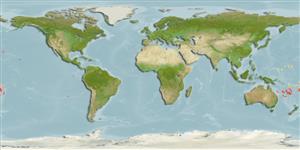>
Eupercaria/misc (Various families in series Eupercaria) >
Callanthiidae (Splendid perches)
Etymology: Grammatonotus: Greek, gramma, atos = signal, mark + Greek, noton = back (Ref. 45335).
More on author: Gilbert.
Environment: milieu / climate zone / depth range / distribution range
Ecologia
marinhas; intervalo de profundidade 170 - 372 m (Ref. 58302). Tropical; 32°N - 25°S, 152°E - 97°W
Western Central Pacific: Papua New Guinea. Southeast Pacific: Cupole Seamount.
Tamanho / Peso / Idade
Maturity: Lm ? range ? - ? cm
Max length : 12.8 cm SL macho/indeterminado; (Ref. 28618)
Ciclo de vida ou comportamento de acasalamento
Maturidade | Reprodução | Desova | Ovos | Fecundidade | Larvas
Kailola, P.J., 1987. The fishes of Papua New Guinea: a revised and annotated checklist. Vol. II Scorpaenidae to Callionymidae. Research Bulletin No. 41, Research Section, Dept. of Fisheries and Marine Resources, Papua New Guinea. (Ref. 6192)
Status na Lista Vermelha da UICN (Ref. 130435: Version 2024-2)
Ameaça para os humanos
Harmless
Uso pelos humanos
Ferramentas
Relatórios especiais
Baixar XML
Fontes da internet
Estimates based on models
Preferred temperature (Ref.
123201): 15.9 - 21.3, mean 19.5 °C (based on 9 cells).
Índice de diversidade filogenética (Ref.
82804): PD
50 = 0.5039 [Uniqueness, from 0.5 = low to 2.0 = high].
Bayesian length-weight: a=0.00977 (0.00379 - 0.02521), b=3.08 (2.86 - 3.30), in cm total length, based on LWR estimates for this (Sub)family-body shape (Ref.
93245).
Nível Trófico (Ref.
69278): 3.3 ±0.4 se; based on size and trophs of closest relatives
Fishing Vulnerability (Ref.
59153): Low vulnerability (10 of 100).
